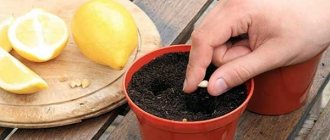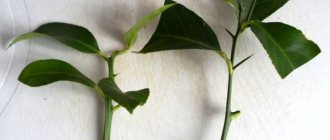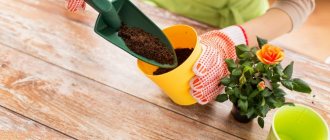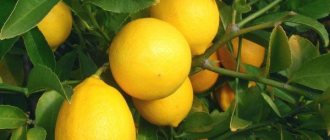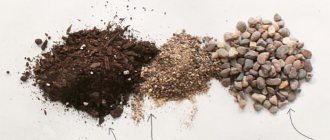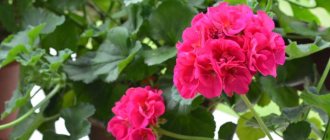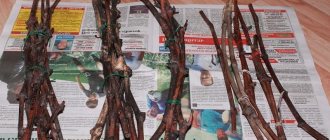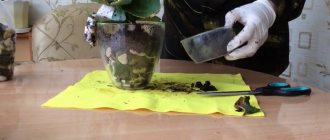Gardening » Citrus » Lemon
0
1006
Article rating
Kira Stoletova
Land for lemon plays a big role in ensuring the growth and development of the plant. Choosing the right soil composition for homemade lemon helps to grow a tree and get high-quality fruits.
Land for homemade lemon
Transplants: frequency and prerequisites
Most citrus seedlings require annual replanting, for several reasons:
- in the first years of life, the plant actively increases its root mass, which, in turn, contributes to the optimal development of its above-ground part;
- in the process of life, the tree changes the pH balance of the earth, which can lead to the creation of unfavorable conditions for it (especially important for growing lemons at home and not in the garden);
- the soil is depleted, this happens especially quickly during periods of active plant growth and during fruit ripening;
- Over time, pathogenic microflora may develop in the soil;
- it is necessary to regularly check the roots of the plant for the presence of rot in order to timely detect and prevent their necrosis.
Until the age of five, homemade lemons need to renew the soil annually - most with an increase in the pot, some varieties - while maintaining its size. In the future, trees need to be replanted every two years. When carrying out the procedure, it is necessary to take into account the acidity of the soil, the requirement of citrus fruits for good drainage, and their sensitivity to possible infections and damage to the roots. All plants of this genus are replanted strictly by turning, and it is not recommended to completely remove the earthen ball, unless we are talking about a complete replacement of the soil. All manipulations with roots are reduced solely to the removal of rotten and dried areas. Expanded clay or minerals should be placed at the bottom of the pot - this will help drain excess moisture. You can also place some stones deep in the ground for indoor lemons to provide ventilation for its roots.
Only in good soil can plants reach their full potential.
The tree should not be replanted during flowering or fruiting, as this may cause the buds and fruits to drop. The best time to replace the soil in a pot is considered to be early spring - before the plant enters the active growing season.
Lemon propagation methods
A seed from the fruit is dropped into the soil for lemons to a depth of no more than 1-1.5 cm; It will in no way resemble a varietal indoor lemon. You can use the bone of a varietal compact tree. But in this case, a plant can also be obtained that has not inherited the characteristics of the mother tree. Germinating a lemon seed is very simple: The most common methods of lemon propagation are: seed propagation, grafting and cuttings. Any variety of lemon can be propagated by seeds. Most often, they take a seed from a purchased ripe fruit and plant it in the ground.
The resulting plant will most likely be very large.
- The soil is periodically moistened; there is no need to cover the crops with film.
Up to 100% of large seeds from ripe fruits germinate. Another disadvantage of seed propagation is that the seedling will not bloom earlier than after 10 years. Therefore, lemon seedlings are grafted with cuttings and eyes from a fruiting varietal specimen.
Grafting is another method of propagation that allows you to obtain varietal lemons on wildflower roots. Cuttings are the most convenient method of propagation. Cuttings of varietal fruit-bearing lemon are harvested during pruning and rooted in the ground. Such plants bloom already 2-3 years after rooting. They completely retain the varietal characteristics of the mother plant. A lemon grown from a cutting does not require grafting.
Soil requirements
The soil for citrus fruits is chosen to be special, meeting certain requirements for acidity and uniformity. Thus, the pH level is preferable within the range of 5.5 – 7.0. This indicator is usually indicated on packages of industrial soils; when preparing the mixture yourself, you can use an electronic tester or litmus to determine it. In the absence of special devices, there is a “folk” way to determine the acid-base balance: put a handful of soil into a chilled infusion of currant leaves and observe the change in color of the liquid. Redness of the broth means high acidity; such soil is unsuitable for lemons.
The soil for citrus fruits should not be heavy, on the contrary: they are more suitable for light, loose, well-drained soils that can ensure rapid absorption of moisture and free access of air to the roots. At the same time, excessive looseness is also not welcome; pure peat will not work. But its mixture with richer, nutritious soils is quite suitable. It’s even better to use a mixture of chernozem with soil taken under birch trees - it has sufficient breathability and is also rich in nutrients.
Ready mixes
It is important to check the soil purchased in the store for quality and acidity. To do this, you need to take a lump of substrate, moisten it with distilled or filtered water, and then apply litmus paper to the lump. If the color of the indicator strip turns green or yellow, the pH level in the soil is normal.
A blue stripe indicates alkaline soil, while a red litmus color indicates that the soil is too acidic.
Advice: it is important to check the store-bought substrate for petroleum product content. To do this, you need to throw a lump of earth into clean water and stir. If the surface of the water is not covered with a film, rainbow or greasy spots, the substrate is of high quality.
If you wish, you can take a small amount of the substrate to the laboratory to study the level of minerals - lemon does not like both high and low levels of minerals in the soil. Also, before using either self-prepared or store-bought soil, it must be calcined - this procedure will help get rid of possible pest larvae, fungal spores (causative agents of diseases), and pathogenic microorganisms.
When purchasing, in addition to the store-bought substrate, you must purchase drainage. This could be: expanded clay, red broken brick, crushed stone, river pebbles and even fragments of pottery.
Soil types, composition
Most often, there are two types of soil mixtures: peat-based or humus-based (vermicompost is also included here). Peat soils are distinguished by a very high level of breathability, they are quite loose, their acidity is regulated by the addition of lime or ash, since it is initially increased. The disadvantages of such soil include its relatively low nutritional value compared to compost-based soils. Peat also has a high ability to absorb moisture, which can lead to waterlogging of plant roots and create the preconditions for their rotting.
The composition of soil for citrus fruits based on humus is much richer and more nutritious, but it is also heavier. Vermicompost itself is an excellent complex fertilizer, so its use promotes the rapid development of the plant and its active growth. Among the negative features of such soils, the main one is the risk of various types of infections - from weeds (relevant for humus, vermicompost is safe in this regard) to helminth eggs and larvae of various insects. It is better to use such soil mixtures in open spaces rather than indoors. Before using humus as soil for indoor plants, care must be taken to disinfect it (calcination, treatment with boiling water or a solution of potassium permanganate).
When preparing the soil, remember that it should be free of lumps
It is impossible to answer unequivocally in which soil to plant a lemon , since it is necessary to take into account the individual characteristics of the plant, its growing season, age, and many other related factors. But the older the plant, the more clay there should be in the soil.
Buying soil: what to look for
For those who find it easier to buy soil for citrus fruits , it is useful to know how to choose it and what points to pay special attention to - even when choosing specialized soils intended exclusively for lemons and tangerines, there are risk factors.
The most important point is the expiration date. The fact is that the active substances in the soil continue to react with each other, even while in a sealed package. Thus, over time, the acid-base balance of the substrate may change, the soil may cake or rot, and mold fungi may appear. If the timing is normal, you should check the uniformity and moisture of the soil - this can be done without opening the packaging. Waterlogged soil will cake and form into lumps, which can be easily felt through polyethylene. If everything is in order, you can buy land for citrus fruits .
After opening the package, there are several other factors to consider. The earth should crumble easily in your hands; the presence of hard lumps and foreign objects (chips, traces of insects) is unacceptable. Next, you need to evaluate the smell of the soil: is there any putrid shades in it, since rotting of the soil will inevitably lead to diseases of the root system. In rare cases, colonies of mold fungi can be found in packages with industrial soils - such soil cannot be used under any pretext, since the fungi are very resistant to a wide variety of reagents. It is more advisable to purchase another soil mixture.
It should also be taken into account that specialized soils can provide the tree with nutrients for no more than one and a half years, after which the soil must be changed. If for young plants such a frequency of transplants is quite acceptable and even recommended, then it is undesirable to disturb a fruit-bearing tree with such procedures every year.
When preparing the soil for a lemon, remember that the composition of the soil for a young plant and for a grown plant is different.
With your own hands
prepare lemon soil at home yourself, but it will require some skills and time. The main things to focus on are acidity and water permeability. There are several well-proven recipes for preparing soil for lemons.
The simplest one has already been given above - it is a mixture of soil from under a birch tree with black soil in equal parts with the addition of sand and ash. For more demanding gardeners, the following recipes will be relevant.
- You will need garden soil, turf soil and coarse sand. It is better to take turf for soil preparation from fields used for grazing. The optimal soil would be one on which clover, chamomile, and bluegrass grow—these herbs prefer soil that is ideally suited for acidity to citrus fruits. It is better to choose sand-based turf - it is lighter. Garden soil should be collected under fruit trees from a depth of up to 7 cm, half a meter from the trunk. You can use the soil lying in heaps near the mole holes - it is loose, crumbly and cleared of debris by the animal itself. The collected soil must be sifted through a sieve to make it homogeneous and remove straw, wood chips and other impurities. If necessary, you need to adjust the acidity - it can be lowered by adding quicklime or wood ash. Sand is added to enhance the breathability of the mixture and make it lighter. All components must be thoroughly mixed until homogeneous - and the lemon soil is ready for use.
- Soil based on leaf soil (soil collected under deciduous trees with inclusions of rotted leaf matter) and humus. The components are mixed in equal proportions, after which river sand is added to them (no more than a tenth of the total mass). You can add a glass of superphosphate and peat - the same amount as sand. Before mixing potentially dangerous parts of the substrate, they should be disinfected by heating in the oven at 90 degrees for an hour or boiling. You should not heat-treat the finished mixture, since such manipulations significantly reduce the nutritional value of the soil and destroy beneficial microflora.
Buy or make it yourself?
For beginning citrus growers, the process of independently preparing a soil mixture can be quite a difficult task; there is a very high risk of making a mistake with acidity, overheating, or vice versa - not effectively treating the soil against possible infections. It is better for such people to use industrial soils, which also require modification - rechecking and adjusting acidity, in some cases disinfecting, adding nutritional supplements. Understanding what kind of soil is needed for lemons will come to a novice citrus grower with experience.
For experienced owners of indoor lemons, it is preferable to prepare the mixture yourself, as this will allow you to adjust the balance of nutrients to the needs of a particular plant. A person who has been growing citrus fruits for many years can accurately determine by the appearance of the tree which components are currently insufficient and which are in excess. The composition of the soil for lemons can be adjusted in one direction or another, and this will not cause any difficulties for him. An untrained person who does not know how to identify such moments risks overfeeding the tree, and this is fraught with serious problems, including the death of the plant.
Proper preparation of the substrate for lemon provides the lion's share of the conditions for its fruiting and active development. However, adding components such as humus, peat or humus does not imply a refusal to apply fertilizers in the future. The first fertilizing should be done within a month after transplanting the plant, and then follow the fertilizer application schedule drawn up in accordance with the growing season.
buy soil for lemons in our online store Citrus Plant Nursery Pavlovsky Lemon. Also at points of sale you can get recommendations on certain soils, necessary additives and subtleties of caring for home fruit trees.
Let's see how to prepare your own soil for young lemons:
Possible problems after the procedure
Transplanting a lemon tree is an operation that must be carried out very carefully so as not to damage the roots. If it was unsuccessful or errors in care were made in the period after it, various problems with the plant may begin. Here are some of them and ways to solve them:
- After replanting, a lemon sheds its leaves - a mistake in care after replanting, when the rays of the sun hit the leaves of the plant, you need to move the lemon to partial shade and wait for it to recover;
- The leaves of the tree turn yellow and gradually fall off - the lemon suffers from excess sunlight, it is a plant of short daylight hours, it needs to be kept in diffused light, especially in the period after transplantation;
- Lemon leaves curl - lack of air humidity during the period after transplantation; you need to regularly spray the tree, as it is very moisture-loving;
- Lemon grows poorly - an unsuccessful transplant severely damaged the roots, the tree will hurt for a long time, good care of it will reduce the recovery time.
Very often, a tree weakened after replanting is attacked by pests. The most common harmful insects living on lemons are:
- Shchitovka;
- Spider mite;
- Aphid;
- Mealybug.
The fight against these insects must begin immediately as soon as they are discovered. Purchased pesticides – acaricides – are used against spider mites. Against the rest - insecticides.
There are also complex preparations that kill all types of pests. The plant is treated twice with an interval of 7-10 days. If necessary, the treatment is repeated until the pests are completely destroyed.

